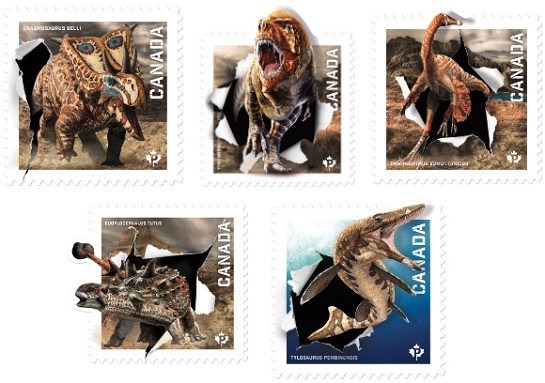
Canada Post brings to life five prehistoric animals that once roamed Canada.The animals depicted are:
Tylosaurus pembinensis, a giant sea-dwelling reptile that could open its jaws wide like a snake and swallow large prey. It patrolled the inland sea that divided North America 80 million years ago. A skeleton displayed at the Canadian Fossil Discovery Centre in Modern, Man. is the largest mosasaur skeleton on exhibit in the world. Nicknamed “Bruce,” the centre refers to it as “the T. rex of the sea.”
Chasmosaurus belli, a relative of the famous Triceratops. Its large frill was supported by a bony framework that was likely used for display, not defence. A baby Chasmosaurus was recently found in Dinosaur Provincial Park. It was less than three years old when it died.
Tyrannosaurus rex, the “tyrant king” of dinosaurs. High school teacher Robert Gebhardt discovered one of the largest and most complete skeletons of its kind in Saskatchewan in 1991. The skeleton has been nicknamed “Scotty.”
Ornithomimus edmontonicus, now known to have sported long arm feathers. It used its speed to outrun predators and to hunt for prey, which included small lizards and mammals.
Euoplocephalus tutus, an herb-eater that was known for its spiky, plated armour. Its complex and unusual series of nasal passages may have warmed inhaled air, improved the animal’s sense of smell or helped it vocalize.
While each stamp frame is 28.5 mm x 28.5 mm, the dinosaurs burst out in varying configurations. The stamps are available in booklets of 10. They were printed by Lowe-Martin and designed by Andrew Perro with illustration byJulius Csotonyi and photography by Judy Arndt. The souvenir sheet of five stamps measures 159 mm x 65 mm. The uncut press sheet of eight souvenir sheets measures 608 mm x 358 mm and features an enlargement of the T. rexthat appears on the stamp. The cancel image on the Official First Day Cover is that of the Ornithomimus edmontonicus. The cancellation site is Drumheller, Alta., home of the Royal Tyrrell Museum of Paleontology, one ofCanada’s most important dinosaur museums.
